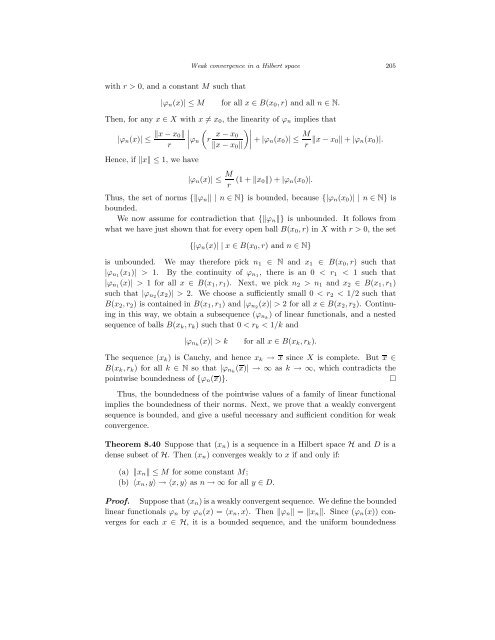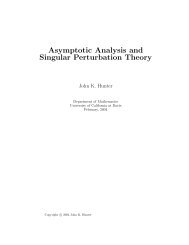Bounded Linear Operators on a Hilbert Space
Bounded Linear Operators on a Hilbert Space
Bounded Linear Operators on a Hilbert Space
You also want an ePaper? Increase the reach of your titles
YUMPU automatically turns print PDFs into web optimized ePapers that Google loves.
with r > 0, and a c<strong>on</strong>stant M such that<br />
Weak c<strong>on</strong>vergence in a <strong>Hilbert</strong> space 205<br />
|ϕn(x)| ≤ M for all x ∈ B(x0, r) and all n ∈ N.<br />
Then, for any x ∈ X with x = x0, the linearity of ϕn implies that<br />
<br />
x − x0 <br />
|ϕn(x)| ≤ <br />
r ϕn <br />
x − x0 <br />
r + |ϕn(x0)| ≤<br />
x − x0<br />
M<br />
r x − x0 + |ϕn(x0)|.<br />
Hence, if x ≤ 1, we have<br />
|ϕn(x)| ≤ M<br />
r (1 + x0) + |ϕn(x0)|.<br />
Thus, the set of norms {ϕn | n ∈ N} is bounded, because {|ϕn(x0)| | n ∈ N} is<br />
bounded.<br />
We now assume for c<strong>on</strong>tradicti<strong>on</strong> that {ϕn} is unbounded. It follows from<br />
what we have just shown that for every open ball B(x0, r) in X with r > 0, the set<br />
{|ϕn(x)| | x ∈ B(x0, r) and n ∈ N}<br />
is unbounded. We may therefore pick n1 ∈ N and x1 ∈ B(x0, r) such that<br />
|ϕn1(x1)| > 1. By the c<strong>on</strong>tinuity of ϕn1, there is an 0 < r1 < 1 such that<br />
|ϕn1(x)| > 1 for all x ∈ B(x1, r1). Next, we pick n2 > n1 and x2 ∈ B(x1, r1)<br />
such that |ϕn2(x2)| > 2. We choose a sufficiently small 0 < r2 < 1/2 such that<br />
B(x2, r2) is c<strong>on</strong>tained in B(x1, r1) and |ϕn2(x)| > 2 for all x ∈ B(x2, r2). C<strong>on</strong>tinuing<br />
in this way, we obtain a subsequence (ϕnk ) of linear functi<strong>on</strong>als, and a nested<br />
sequence of balls B(xk, rk) such that 0 < rk < 1/k and<br />
|ϕnk (x)| > k for all x ∈ B(xk, rk).<br />
The sequence (xk) is Cauchy, and hence xk → x since X is complete. But x ∈<br />
B(xk, rk) for all k ∈ N so that |ϕnk (x)| → ∞ as k → ∞, which c<strong>on</strong>tradicts the<br />
pointwise boundedness of {ϕn(x)}. <br />
Thus, the boundedness of the pointwise values of a family of linear functi<strong>on</strong>al<br />
implies the boundedness of their norms. Next, we prove that a weakly c<strong>on</strong>vergent<br />
sequence is bounded, and give a useful necessary and sufficient c<strong>on</strong>diti<strong>on</strong> for weak<br />
c<strong>on</strong>vergence.<br />
Theorem 8.40 Suppose that (xn) is a sequence in a <strong>Hilbert</strong> space H and D is a<br />
dense subset of H. Then (xn) c<strong>on</strong>verges weakly to x if and <strong>on</strong>ly if:<br />
(a) xn ≤ M for some c<strong>on</strong>stant M;<br />
(b) 〈xn, y〉 → 〈x, y〉 as n → ∞ for all y ∈ D.<br />
Proof. Suppose that (xn) is a weakly c<strong>on</strong>vergent sequence. We define the bounded<br />
linear functi<strong>on</strong>als ϕn by ϕn(x) = 〈xn, x〉. Then ϕn = xn. Since (ϕn(x)) c<strong>on</strong>verges<br />
for each x ∈ H, it is a bounded sequence, and the uniform boundedness
















